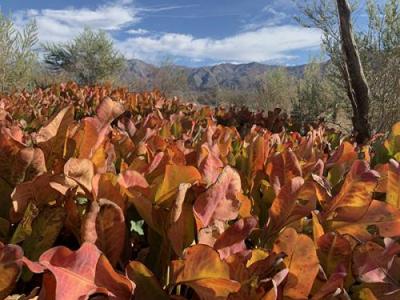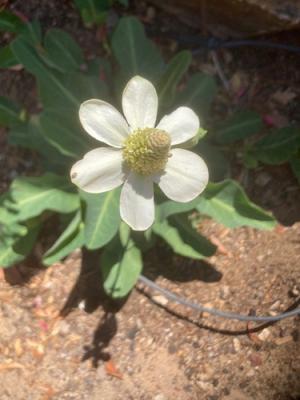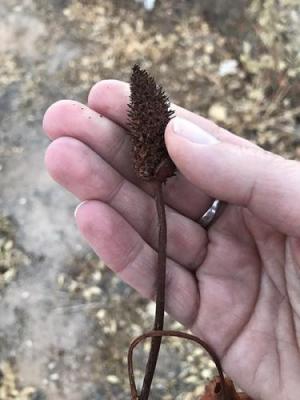February 5, 2022
Knowing and Growing Yerba Mansa
Question:
I’m wondering how to best care for the yerba mansa plants in my garden. After planting them in the spring, they took really well and looked healthy throughout the hot summer. Now the dried leaves and flower stalks are reddish-brown. Is it better to remove last year’s growth or leave it be?
- Lin Y., Los Lunas
Answer:
I’m glad you asked because I have wondered the same thing, and I welcome the chance to learn more about this interesting plant. If you’re unfamiliar with yerba mansa (Anemopsis californica), this is a great opportunity to join the fan club. Here are some onboarding details for new fan club members:

Famous for its medicinal properties, yerba mansa is endemic to western North America, from Oklahoma up to Oregon and down into northern Mexico. Its range is wide, but this relatively small perennial grows specifically in low-lying wetland areas or where water pools temporarily, like after a rain. You’re likely to find dozens or even hundreds of plants growing tightly together in the same places that I have—next to trails in the Rio Grande bosque, in the swales alongside the Rail Runner train tracks in Los Lunas and Belen, in the marshes at the Bosque del Apache National Wildlife Refuge and the Mesilla Bosque State Park, as well as in backyards like mine and my neighbors’. I get excited every time I see it.
In the summer, look for a flowerhead that consists of bright white petal-like bracts arranged around a cone-shaped cluster of tiny flowers. To me, it resembles a white zinnia flower with spinach- or yellow chard-looking leaves that form a rosette at the base of each flower stalk. In the fall and winter, the whole plant changes color, first to a pinky orange, then rusty red, and finally dark brown, almost black. The stem, flowerhead, and basal leaves become crispy as they dry.
In Robert DeWitt Ivey’s Flowering Plants of New Mexico, 5th ed., yerba mansa is described as growing in “marshy places,” and a miniature state map with a shaded area depicting the general distribution range includes almost two-thirds of the state, excluding the Llano Estacado in eastern New Mexico and the higher mountainous regions north of Santa Fe.
Most online descriptions of yerba mansa state that it can be found at elevations below 6,500 ft. I logged onto iNaturalist (a web- and smartphone-based, interactive resource created by The National Geographic Society & The California Academy of Sciences) to see where it’s been geolocated to date. Yerba mansa had 3,754 total observations entered by 2,222 observers. Of those, 248 were tagged in New Mexico—mostly along the middle Rio Grande Valley and falling within the distribution illustrated by Ivey. The ones at higher elevations surprised me. The three highest entries were north of Ojo Caliente at 6,650 ft, near Tijeras at 6,663 ft, and at the Montezuma Hot Springs at 6,745 ft.

Data like these make me stop to wonder: Is the distribution of yerba mansa changing in response to the climate crisis? Has the distribution changed since Ivey’s 5th edition was published in 2008?
Luckily, I have two other editions handy on my bookshelf. In the 2nd edition (1986), distribution maps for each species are not included. But they are included in the 3rd edition (1995). I didn’t think my respect for the late Robert DeWitt Ivey could get any higher, but I was wrong. The distribution map of yerba mansa was updated between 1995 and 2008 to include what appears to be De Baca County and more of Torrance County. Please note: These mini-maps are actually thumbnail-sized, and I did my best to estimate areas covered.
While I imagine that these particular map updates and distribution changes were made largely to incorporate additional plant location information, and therefore not necessarily indicative of an actual shift in distribution due to the climate crisis, I am still profoundly impressed by Ivey’s dedication to sharing accurate knowledge.
I’m curious about the map details in the 4th edition, published in 2003. If you have a copy, please check and share your findings. And I wonder too: Where else are people finding yerba mansa? When you see it while you’re out and about, or in your own yard, take a photo and post it on iNaturalist or share it with me (desertblooms@nmsu.edu). Or both!

As I was clicking around the iNaturalist website and getting energized about writing this column, I switched from the map view of yerba mansa observations to the photo gallery and found a trove of beautiful images of this plant in all its different growth stages. I stopped scrolling when I found stunning photos of yerba mansa glowing orange in Death Valley National Park this past November, and I remembered the original question for this week.
I reached out to Dara Saville, founder and director of the Yerba Mansa Project, a non-profit organization focused on ecology, education, and restoration of plants in their native habitats. Saville is also the founder of Albuquerque Herbalism, a bioregional herbal studies program, and the author of The Ecology of Herbal Medicine. When asked about landscape maintenance of yerba mansa, she responded: “I recommend keeping the winter leaves in place. They add beautiful color in the winter garden and they are good hibernation habitat for small critters. Also, the dormant parts are still actually medicinal if you can believe that!”
Saville offered these two resources for more information about yerba mansa:
- The Journal of the American Herbalists Guild - accessible online
- Charles Kane's book, Medicinal Plants of the American Southwest.
For more photos of yerba mansa and close-ups of the thumbnail distribution maps, visit the blog version of the Desert Blooms column.
Marisa Y. Thompson, PhD, is the Extension Horticulture Specialist, in the Department of Extension Plant Sciences at the New Mexico State University Los Lunas Agricultural Science Center, email: desertblooms@nmsu.edu, office: 505-865-7340, ext. 113.
Links:
For more gardening information, visit the NMSU Extension Horticulture page at Desert Blooms and the NMSU Horticulture Publications page.
Send gardening questions to Southwest Yard and Garden - Attn: Dr. Marisa Thompson at desertblooms@nmsu.edu, or at the Desert Blooms Facebook page.
Please copy your County Extension Agent and indicate your county of residence when you submit your question!